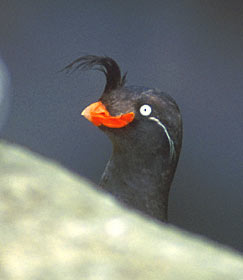Week 48 – 11 June 2017:
As Though Seabirds Weren’t Already Cool Enough…
Some of the most beautiful traits that we admire in birds have evolved under the influence of sexual selection. Preference for a particular trait by members of one sex can, over time, lead an elaboration of that characteristic in members of the other sex. The more exaggerated the trait, the more appealing the individual. A recent publication by Christy Wails of the University of New Brunswick and her coworkers details a fascinating, previously undescribed characteristic of a stunning seabird, the Crested Auklet. It seems that the bill plates of Crested Auklets fluoresce.
I consulted with Wails, now a Ph.D. student at Northern Illinois University. I confessed to her that I knew very little about bill plates. Christy explained that “bill plates are keratinaceous accessory plates that Crested Auklets produce around the onset of the breeding season. As chick hatch… these bill plates become loose and they’re shed, leaving a dull bill through the non-breeding season.”
Crested, Least and Parakeet auklets were studied by Wails and crew at Gareloi Island in Alaska. There is a breeding colony of about 460,000 auklets on the island. Individual birds were briefly exposed to blue light. No part of Least and Parakeet auklets fluoresced, but the bright orange plates on the bill and around the mouths of all Crested Auklets fluoresced when exposed to blue light. It was something of a chance discovery that came about when the crew was stuck in camp as a result of rainy weather. Two members of the field crew had NightSea blue flashlights; the fluorescence was unexpected.
The Crested Auklet paper was a one-off for Wails, as she has moved on to studies of other seabirds in New Zealand. A few of her colleagues are interested in taking the study forward. It is likely to be a fruitful avenue for study.
Our understanding of the vision of birds is still rather limited. It is clear that many birds can see near-ultraviolet light, but most seabird probably don’t. The fluorescent light given off by the bills of Crested Auklets in the breeding season is something that they can almost certainly see, and may be a characteristic that is used in mate selection. Further research will be needed to determine whether the observed fluorescence is the result of a pigment, as Wails et al. suspect, or whether it is a result of physical characteristics of the bill plates playing tricks with the light. I suspect that an ornithologist with an appropriate blue light might have a fun and fruitful afternoon examining museum specimens of seabirds in one of the larger research collections in Britain or the United States.
Wails, C. N., E. D. Gruber, E. Slattery, L. Smith, and H. L. Major. 2017. Glowing in the light: fluorescence of bill plates in the Crested Auklet (Aethia cristatella). Wilson J. Ornithology 129:155-158.
Photo credits: Crested Auklet portrait © Mike Danzenbaker - avesphoto.com; Crested Auklet photograph of full bird – www.pinterest.com


